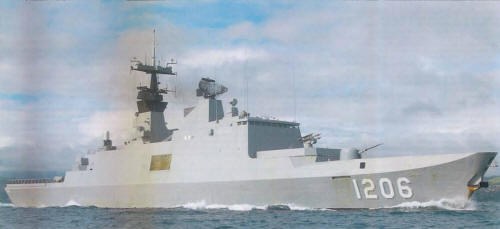
NAVYPEDIA
 Support the project with paypal
Support the project with paypal
Photo

Di Hua 2006
Ships
| Name | No | Yard No | Builder | Laid down | Launched | Comm | Fate |
|---|---|---|---|---|---|---|---|
| 康定 [Kang Ding] | 1202 | DCN, Lorient, France | 1.8.1993 | 12.3.1994 | 24.5.1996 | in service (2019) | |
| 西寧 [Hsi Ning] | 1203 | DCN, Lorient, France | 28.3.1994 | 5.11.1994 | 12.10.1996 | in service (2019) | |
| 昆明 [Kun Ming] | 1205 | DCN, Lorient, France | 7.11.1994 | 13.5.1995 | 26.2.1997 | in service (2019) | |
| 迪化 [Di Hua] | 1206 | DCN, Lorient, France | 1.7.1995 | 26.11.1995 | 8.8.1997 | in service (2019) | |
| 武昌 [Wu Chang] | 1207 | DCN, Lorient, France | 1.7.1995 | 26.11.1995 | 16.12.1997 | in service (2019) | |
| 承德 [Chen De] | 1208 | DCN, Lorient, France | 27.12.1995 | 2.8.1996 | 19.3.1998 | in service (2019) |
Technical data
| Displacement standard, t | 3000 |
|---|---|
| Displacement full, t | 3800 |
| Length, m | 115.0 pp 124.2 oa |
| Breadth, m | 15.4 deck 13.8 wl |
| Draught, m | 4.00 hull 5.50 max |
| No of shafts | 2 |
| Machinery | 4 SEMT-Pielstick 12 PA 6 V280 STC diesels |
| Power, h. p. | 21000 |
| Max speed, kts | 25 |
| Fuel, t | diesel oil |
| Endurance, nm(kts) | 7000(15) |
| Armament | 2 x 4 Hsiung Feng II SSM (8 Hsiung Feng II), 1 x 4 Sea Chaparral SAM (16 MIM-72F), 1 x 1 - 76/62 OTO-Melara Compact, 2 x 1 - 40/70 Bofors 564, 1 x 6 - 20/76 Mk 15 Phalanx, 2 x 3 - 324 Mk 32 TT, 1 helicopter (S-70C Thunderhawk) |
| Electronic equipment | 1202, 1203, 1205, 1207, 1208: 2x Racal-Decca 20V90, Jupiter, Triton G, 2x Castor IIC, Mk 90 radars, 2x Najir e/o directors, Spherion B sonar, provision for Lamproie ATBF ATAS(v)2 sonar, DR 3000S ECM suite, 2x Dagaie decoy RL, TAVITAC-2000 CCS 1206: 2x Racal-Decca 20V90, Jupiter, Triton G, 2x Castor IIC, Mk 90 radars, 2x Najir e/o directors, Spherion B sonar, provision for Lamproie ATBF ATAS(v)2 sonar, Chang Feng IV ECM suite, 2x Dagaie decoy RL, TAVITAC-2000 CCS |
| Complement | 164 |
Standard scale images

Kang Ding 2010
Graphics
Project history
Also referred to by Taiwan as the PF class and by the builders as the FL-3000 class or MOP-1 class. Originally, France was to deliver the first six hulls without weapons or sensors to Taiwan for fitting out (earlier it had been proposed to deliver the hulls in prefabricated sections). In 1993, however, it was decided to build the six ships under contract entirely in France, saving about $120 million. In 1994 France and the People's Republic of China announced that no more orders would be accepted, but that was later clarified to mean that no more beyond the total of 14 on option, but no more have been ordered. The ships are named for the capital cities of mainland Chinese provinces.
A particular effort has been made to reduce the ships' signatures; the diesel propulsion engines are mounted in pairs on isolation platforms, and the superstructure, masts, and forecastle are covered with radar-absorbent GRP-resin compound. Much of the superstructure is built of GRP. Vertical hull and superstructure surfaces are slanted at plus or minus 10 degrees to reduce radar reflectivity. The ships are also fitted with degaussing equipment and extensive NBC warfare protection. Special armor is provided for the magazines. All chocks, bollards, and boat recesses are covered to reduce radar reflectivity. Employ a modified deep-vee hull form, fin stabilizers, and rudder-controlled roll reduction to improve seaworthiness. There are two rudders, and the hull form incorporates twin skegs aft. The French SAMAHE helicopter deck downhaul and deck transiting system turned out to be incompatible with the S-70C(M)1 helicopter and has been modified; the helicopter can be launched and recovered in up to Sea State 6. Boats are stowed in superstructure recesses that are covered to reduce radar reflection.
Modernizations
None.
Naval service
No significant events.
© Ivan Gogin, 2017-19
 HOME
HOME FIGHTING SHIPS OF THE WORLD
FIGHTING SHIPS OF THE WORLD TAIWAN
TAIWAN ESCORTS
ESCORTS KANG DING frigates (1996-1998)
KANG DING frigates (1996-1998)
